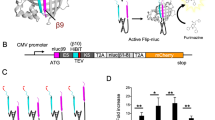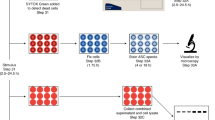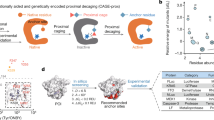Abstract
Measurement of protease activity in living cells or organisms remains a challenging task. We here present a transgene-encoded biosensor that reports the proteolytic activity of caspase-1 in the course of inflammasome activation and that of other proteases in a highly sensitive and specific manner. This protease reporter is based on the biological activity of a pro–interleukin (IL)-1β–Gaussia luciferase (iGLuc) fusion construct, in which pro–IL-1β–dependent formation of protein aggregates renders GLuc enzyme inactive. Cleavage leads to monomerization of this biosensor protein, resulting in a strong gain in luciferase activity. Exchange of the canonical caspase-1 cleavage site in this reporter construct allows the generation of protease biosensors with additional specificities. The high sensitivity, signal-to-background ratio and specificity of the iGLuc system renders it a useful tool to study proteolytic events in mouse and human cells at high throughput and to monitor protease activity in mice in vivo.
This is a preview of subscription content, access via your institution
Access options
Subscribe to this journal
Receive 12 print issues and online access
$259.00 per year
only $21.58 per issue
Buy this article
- Purchase on Springer Link
- Instant access to full article PDF
Prices may be subject to local taxes which are calculated during checkout






Similar content being viewed by others
References
Martinon, F., Mayor, A. & Tschopp, J. The inflammasomes: guardians of the body. Annu. Rev. Immunol. 27, 229–265 (2009).
Bauernfeind, F. et al. Inflammasomes: current understanding and open questions. Cell. Mol. Life Sci. 68, 765–783 (2011).
Dinarello, C.A. Immunological and inflammatory functions of the interleukin-1 family. Annu. Rev. Immunol. 27, 519–550 (2009).
Hoffman, H.M., Mueller, J.L., Broide, D.H., Wanderer, A.A. & Kolodner, R.D. Mutation of a new gene encoding a putative pyrin-like protein causes familial cold autoinflammatory syndrome and Muckle-Wells syndrome. Nat. Genet. 29, 301–305 (2001).
Masters, S.L., Simon, A., Aksentijevich, I. & Kastner, D.L. Horror autoinflammaticus: the molecular pathophysiology of autoinflammatory disease. Annu. Rev. Immunol. 27, 621–668 (2009).
Martinon, F., Petrilli, V., Mayor, A., Tardivel, A. & Tschopp, J. Gout-associated uric acid crystals activate the NALP3 inflammasome. Nature 440, 237–241 (2006).
Duewell, P. et al. NLRP3 inflammasomes are required for atherogenesis and activated by cholesterol crystals. Nature 464, 1357–1361 (2010).
Masters, S.L. et al. Activation of the NLRP3 inflammasome by islet amyloid polypeptide provides a mechanism for enhanced IL-1β in type 2 diabetes. Nat. Immunol. 11, 897–904 (2010).
Halle, A. et al. The NALP3 inflammasome is involved in the innate immune response to amyloid-β. Nat. Immunol. 9, 857–865 (2008).
Bauernfeind, F. et al. Cutting edge: reactive oxygen species inhibitors block priming, but not activation, of the NLRP3 inflammasome. J. Immunol. 187, 613–617 (2011).
Bauernfeind, F.G. et al. Cutting edge: NF-κB activating pattern recognition and cytokine receptors license NLRP3 inflammasome activation by regulating NLRP3 expression. J. Immunol. 183, 787–791 (2009).
Franchi, L., Eigenbrod, T. & Nunez, G. Cutting edge: TNF-α mediates sensitization to ATP and silica via the NLRP3 inflammasome in the absence of microbial stimulation. J. Immunol. 183, 792–796 (2009).
Dodé, C. et al. New mutations of CIAS1 that are responsible for Muckle-Wells syndrome and familial cold urticaria: a novel mutation underlies both syndromes. Am. J. Hum. Genet. 70, 1498–1506 (2002).
Kim, S. et al. Listeria monocytogenes is sensed by the NLRP3 and AIM2 inflammasome. Eur. J. Immunol. 40, 1545–1551 (2010).
Lazebnik, Y.A., Kaufmann, S.H., Desnoyers, S., Poirier, G.G. & Earnshaw, W.C. Cleavage of poly(ADP-ribose) polymerase by a proteinase with properties like ICE. Nature 371, 346–347 (1994).
Garcia-Calvo, M. et al. Purification and catalytic properties of human caspase family members. Cell Death Differ. 6, 362–369 (1999).
Takenaka, Y. et al. Two forms of secreted and thermostable luciferases from the marine copepod crustacean, Metridia pacifica. Gene 425, 28–35 (2008).
Hornung, V. et al. AIM2 recognizes cytosolic dsDNA and forms a caspase-1-activating inflammasome with ASC. Nature 458, 514–518 (2009).
Mahajan, N.P., Harrison-Shostak, D.C., Michaux, J. & Herman, B. Novel mutant green fluorescent protein protease substrates reveal the activation of specific caspases during apoptosis. Chem. Biol. 6, 401–409 (1999).
Fan, F. et al. Novel genetically encoded biosensors using firefly luciferase. ACS Chem. Biol. 3, 346–351 (2008).
Demon, D. et al. Caspase substrates: easily caught in deep waters? Trends Biotechnol. 27, 680–688 (2009).
Timmer, J.C. & Salvesen, G.S. Caspase substrates. Cell Death Differ. 14, 66–72 (2007).
Kutner, R.H., Zhang, X.Y. & Reiser, J. Production, concentration and titration of pseudotyped HIV-1-based lentiviral vectors. Nat. Protoc. 4, 495–505 (2009).
Acknowledgements
We thank M. Rossner (Max Planck Institute for Experimental Medicine) for providing us with pCMV-TEV, B. Kümmerer (University Hospital, University of Bonn) for the pMetLuc control, W. Barchet (University Hospital, University of Bonn) for GM-CSF supernatant and Millennium Pharmaceuticals for NLRP3- and NLRC4-deficient mice. V.H. is member of the excellence cluster ImmunoSensation and is supported by grants from the German Research Foundation (SFB704) and the European Research Council (ERC-2009-StG 243046).
Author information
Authors and Affiliations
Contributions
E.B., F.B. and V.H. designed experiments, analyzed the data and wrote the manuscript. E.B., F.B., M.G.K., C.J., B.M., E.L. and V.H. performed experiments. K.A.F. and E.L. assisted with data collection and interpretation. V.H. conceived and supervised the project.
Corresponding author
Ethics declarations
Competing interests
The authors declare no competing financial interests.
Supplementary information
Supplementary Text and Figures
Supplementary Figures 1–18, Supplementary Tables 1 and 2 and Supplementary Notes 1–3 (PDF 37143 kb)
Rights and permissions
About this article
Cite this article
Bartok, E., Bauernfeind, F., Khaminets, M. et al. iGLuc: a luciferase-based inflammasome and protease activity reporter. Nat Methods 10, 147–154 (2013). https://doi.org/10.1038/nmeth.2327
Received:
Accepted:
Published:
Issue Date:
DOI: https://doi.org/10.1038/nmeth.2327
This article is cited by
-
Novel targeted mtLivin nanoparticles treatment for disseminated diffuse large B-cell lymphoma
Oncogene (2021)
-
Self-guarding of MORC3 enables virulence factor-triggered immunity
Nature (2021)
-
AAV-based dual-reporter circuit for monitoring cell signaling in living human cells
Journal of Biological Engineering (2017)
-
Development of a luciferase-based biosensor to assess enterovirus 71 3C protease activity in living cells
Scientific Reports (2017)
-
Neutrophils mediate Salmonella Typhimurium clearance through the GBP4 inflammasome-dependent production of prostaglandins
Nature Communications (2016)



